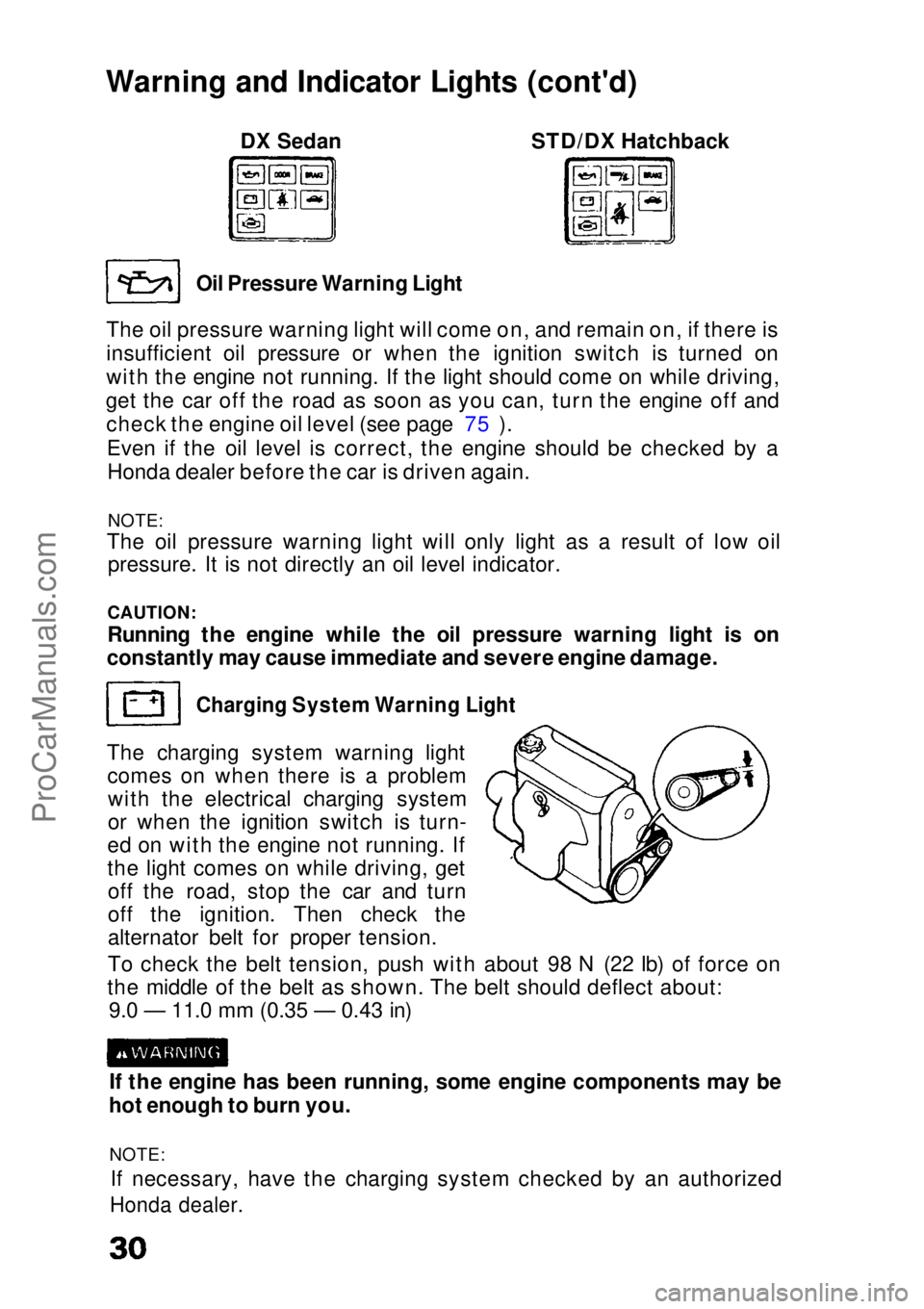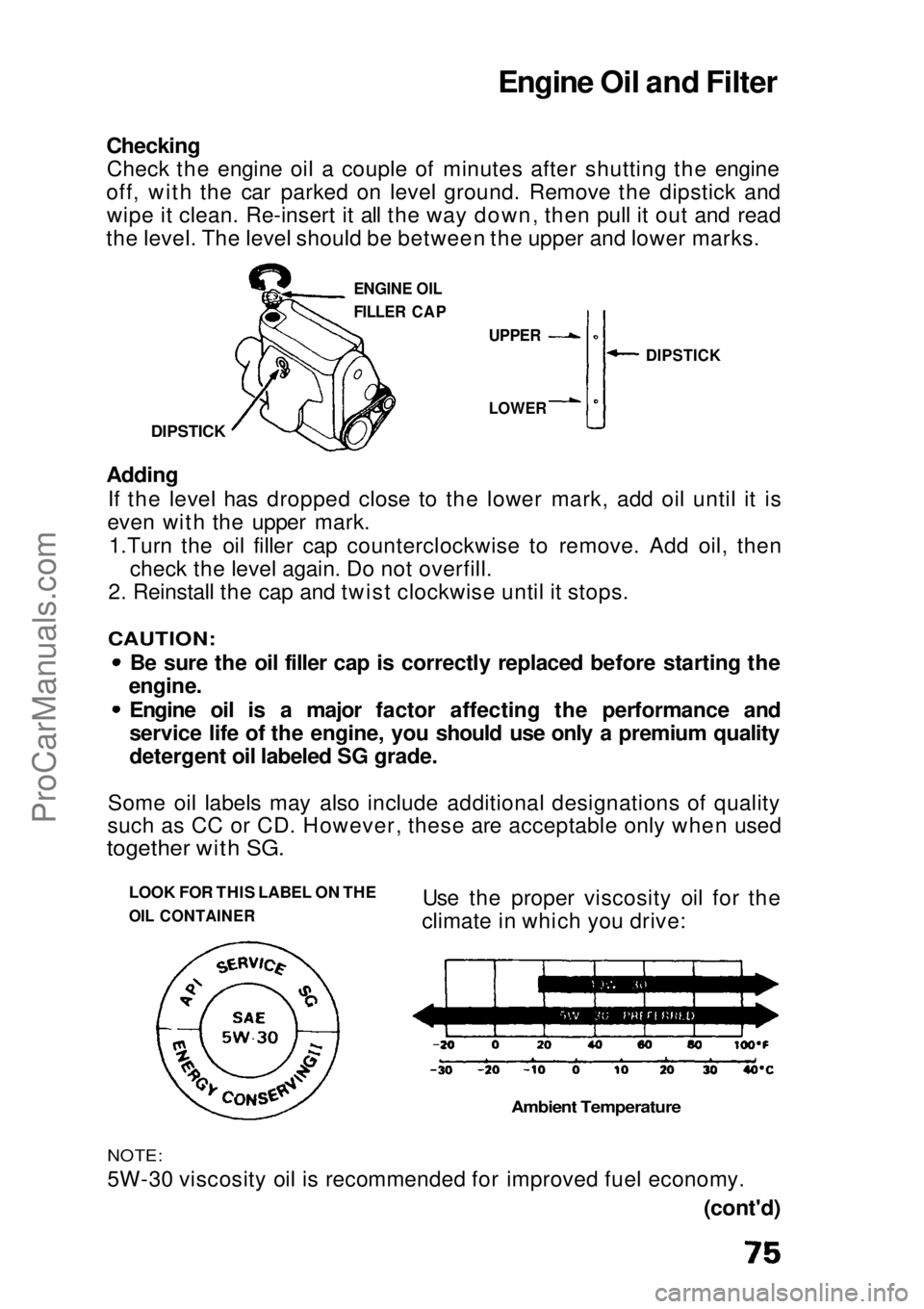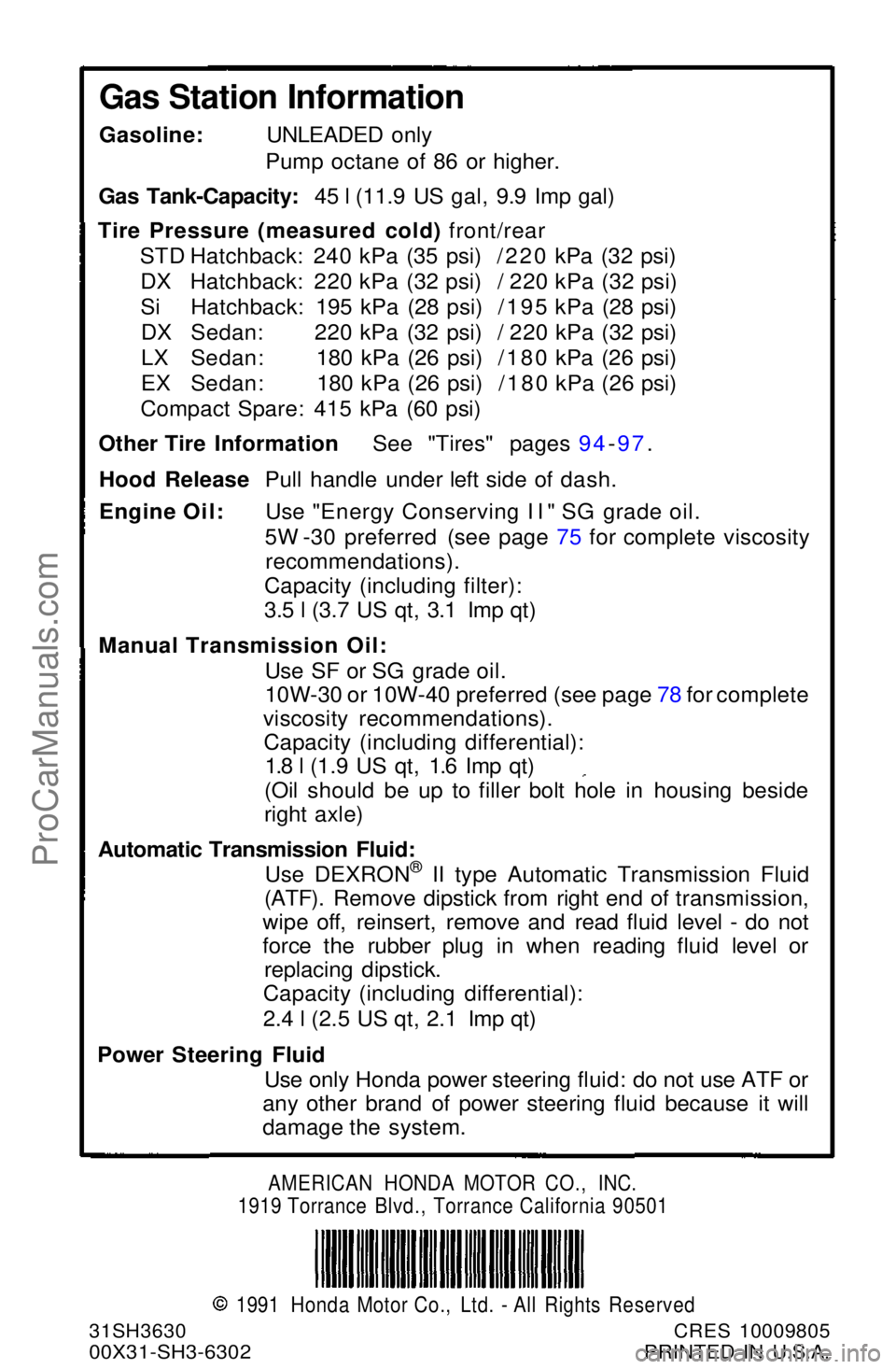Page 31 of 136

Warning and Indicator Lights (cont'd)
DX Sedan STD/DX Hatchback
Oil Pressure Warning Light
The oil pressure warning light will come on, and remain on, if there is
insufficient oil pressure or when the ignition switch is turned on
with the engine not running. If the light should come on while driving,
get the car off the road as soon as you can, turn the engine off and check the engine oil level (see page 75 ).
Even if the oil level is correct, the engine should be checked by aHonda dealer before the car is driven again.
NOTE:
The oil pressure warning light will only light as a result of low oil
pressure. It is not directly an oil level indicator.
CAUTION:
Running the engine while the oil pressure warning light is on
constantly may cause immediate and severe engine damage.
Charging System Warning Light
The charging system warning light comes on when there is a problemwith the electrical charging system
or when the ignition switch is turn-
ed on with the engine not running. If
the light comes on while driving, get off the road, stop the car and turn
off the ignition. Then check the
alternator belt for proper tension.
To check the belt tension, push with about 98 N (22 Ib) of force on
the middle of the belt as shown. The belt should deflect about: 9.0 — 11.0 mm (0.35 — 0.43 in)
If the engine has been running, some engine components may be
hot enough to burn you.
NOTE: If necessary, have the charging system checked by an authorized
Honda dealer.ProCarManuals.comMain Menu s t
Page 69 of 136
Check the following items at each fuel stop:
1. Engine oil level.
2. Radiator coolant level.
Check the following items periodically: 1. Brakes: for braking efficiency, brake pedal travel and hydraulic
fluid level.
2. Lights: for operation of headlights, taillights, side marker lights, stoplights, turn signals and back-up lights.
3. Tires: for correct pressures (including spare); inspect for cuts and uneven or excessive wear. Rotate every 7,500 miles (12,000 km)
in the pattern shown on page 97.
4. Steering: for excessive play or vibration while driving. 5. Exhaust system: for leaks or loose mounts.
6. Wipers: for operation of windshield wipers and washer, and condition of wiper blades.
7. Seat belts: for condition of fabric and buckles, and operation of the restraint mechanism.
8. Battery condition.
9. Clutch adjustment (clutch pedal free travel).
(cont'd)ProCarManuals.comMain Menu s t
Page 70 of 136
Maintenance Schedule and Records (cont'd)
Check oil and coolant level at each fuel stop.Under severe driving conditions, service these items twice as often. (See page 72)ProCarManuals.comMain Menu s t
Page 75 of 136

Engine Oil and Filter
Checking
Check the engine oil a couple of minutes after shutting the engine
off, with the car parked on level ground. Remove the dipstick and wipe it clean. Re-insert it all the way down, then pull it out and read
the level. The level should be between the upper and lower marks.
DIPSTICK
ENGINE OIL
FILLER CAP
Adding
If the level has dropped close to the lower mark, add oil until it is
even with the upper mark.
1.Turn the oil filler cap counterclockwise to remove. Add oil, then check the level again. Do not overfill.
2. Reinstall the cap and twist clockwise until it stops.
CAUTION:
Be sure the oil filler cap is correctly replaced before starting the
engine.
Engine oil is a major factor affecting the performance and
service life of the engine, you should use only a premium quality
detergent oil labeled SG grade.
Some oil labels may also include additional designations of quality
such as CC or CD. However, these are acceptable only when used
together with SG.
LOOK FOR THIS LABEL ON THE
OIL CONTAINER
Use the proper viscosity oil for the
climate in which you drive:
Ambient Temperature
NOTE:
5W-30 viscosity oil is recommended for improved fuel economy.
(cont'd)
DIPSTICK
LOWER UPPERProCarManuals.comMain Menu s t
Page 77 of 136
6. Reinstall the filler cap securely.
7. Start the engine and make sure oil is not leaking from the drain
bolt or the filter.
8. Shut off the engine and recheck the oil level.
NOTE:Please dispose of used motor oil in a manner that is compatible with
the environment. We suggest you take it in a sealed container to
your local service station for reclamation. Do not throw it in the
trash or pour it on the ground.
CAUTION:
Used motor oil may cause skin cancer if repeatedly left in contact
with the skin for prolonged periods. Although this is unlikely
unless you handle used oil on a daily basis, it is still advisable to
thoroughly wash your hands with soap and water as soon as possible after handling used oil.ProCarManuals.comMain Menu s t
Page 78 of 136

Transmission Oil/Fluid Check
Transmission oil/fluid must be checked with the engine off and the
car on level ground.
If the engine has been running, some engine components may be
hot enough to burn you.
CAUTION:
If the oil/fluid level is low, check for possible leaks before adding
oil. Do not overfill.
Since the transmission and differential are in the same housing, you
are actually checking both oil/fluid levels in one procedure. Change
transmission oil/fluid according to the Maintenance Schedule on
page 70.
Manual
Remove the oil filler bolt (beside the right axle). Feel inside the bolt
hole with your finger. If the oil is up to the bottom edge of the hole,
the oil level is correct. If it is not, slowly add oil until it runs out of
the hole, then reinstall the bolt and tighten it securely with a wrench.
MANUAL TRANSMISSION OIL CHANGE CAPACITY: 1.8 (1.9 US qt, 1.6 Imp qt)
Use only SF or SG grade motor oil when adding or changing transmis-
sion oil. OIL CHECK/
FILLER BOLT
CORRECT LEVELProCarManuals.comMain Menu s t
Page 79 of 136
Use the proper viscosity oil
for the climate in which
you drive:
Ambient Temperature
Automatic
The automatic transmission fluid level is checked (with the engine off and the car on level ground) using the dipstick on the passenger
side of the transmission housing. Remove the dipstick and wipe it
DIPSTICK
UPPER
LOWER
Insert the dipstick and remove it. The fluid level should be between
the upper and lower marks. If necessary, add fluid and recheck. Use only DEXRON
Automatic Transmission Fluid (A.T.F.) when adding or changing fluid.
After checking the fluid level, push the dipstick in securely
AUTOMATIC TRANSMISSION FLUID CHANGE CAPACITY: 2.4 (2.5
US qt, 2.1 Imp qt)ProCarManuals.comMain Menu s t
Page 136 of 136

AMERICAN HONDA MOTOR CO., INC.
1919 Torrance Blvd., Torrance California 90501 1991 Honda Motor Co., Ltd. - All Rights Reserved
31SH3630 CRES 10009805
00X31-SH3-6302 PRINTED IN U.S.A.
Gas Station Information
Gasoline: UNLEADED only
Pump octane of 86 or higher.
Gas Tank-Capacity: 45 l (11.9 US gal, 9.9 Imp gal)
Tire Pressure (measured cold) front/rear STD Hatchback: 240 kPa (35 psi) /220 kPa (32 psi)DX Hatchback: 220 kPa (32 psi) / 220 kPa (32 psi)
Si Hatchback: 195 kPa (28 psi) /195 kPa (28 psi)DX Sedan: 220 kPa (32 psi) / 220 kPa (32 psi)
LX Sedan: 180 kPa (26 psi) /180 kPa (26 psi)
EX Sedan: 180 kPa (26 psi) /180 kPa (26 psi)
Compact Spare: 415 kPa (60 psi)
Other Tire Information See "Tires" pages 94-97.
Hood Release Pull handle under left side of dash.
Engine Oil: Use "Energy Conserving II" SG grade oil. 5W -30 preferred (see page 75 for complete viscosityrecommendations).
Capacity (including filter):
3.5 l (3.7 US qt, 3.1 Imp qt)
Manual Transmission Oil: Use SF or SG grade oil.
10W-30 or 10W-40 preferred (see page 78 for complete
viscosity recommendations). Capacity (including differential): 1.8 l (1.9 US qt, 1.6 Imp qt)
(Oil should be up to filler bolt hole in housing beside
right axle)
Automatic Transmission Fluid:
Us
e
DEXRON® II type Automatic Transmission Fluid
(ATF). Remove
dipstick from right end of transmission,
wipe off, reinsert, remove and read fluid level - do not
force the rubber plug in when reading fluid level or replacing dipstick.
Capacity (including differential):
2.4 l (2.5 US qt, 2.1 Imp qt)
Power Steering Fluid Use only Honda power steering fluid: do not use ATF or
any other brand of power steering fluid because it will
damage the system.ProCarManuals.comMain Menu s t